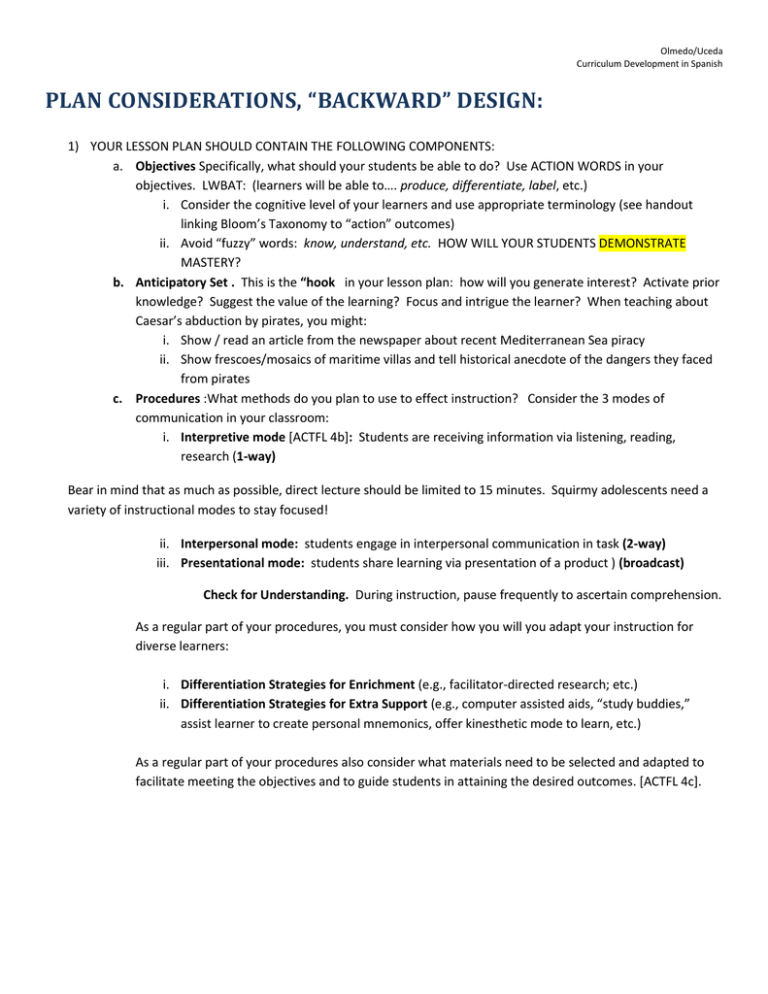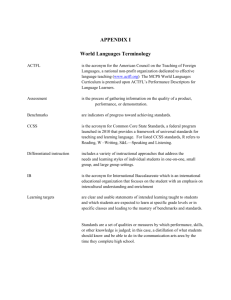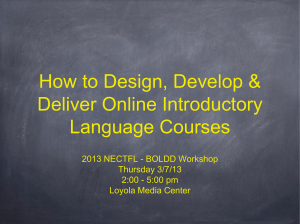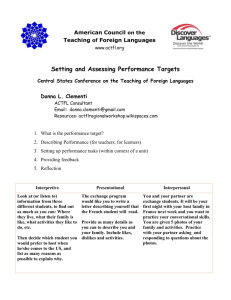plan considerations, “backward” design
advertisement

Olmedo/Uceda Curriculum Development in Spanish PLAN CONSIDERATIONS, “BACKWARD” DESIGN: 1) YOUR LESSON PLAN SHOULD CONTAIN THE FOLLOWING COMPONENTS: a. Objectives Specifically, what should your students be able to do? Use ACTION WORDS in your objectives. LWBAT: (learners will be able to…. produce, differentiate, label, etc.) i. Consider the cognitive level of your learners and use appropriate terminology (see handout linking Bloom’s Taxonomy to “action” outcomes) ii. Avoid “fuzzy” words: know, understand, etc. HOW WILL YOUR STUDENTS DEMONSTRATE MASTERY? b. Anticipatory Set . This is the “hook in your lesson plan: how will you generate interest? Activate prior knowledge? Suggest the value of the learning? Focus and intrigue the learner? When teaching about Caesar’s abduction by pirates, you might: i. Show / read an article from the newspaper about recent Mediterranean Sea piracy ii. Show frescoes/mosaics of maritime villas and tell historical anecdote of the dangers they faced from pirates c. Procedures :What methods do you plan to use to effect instruction? Consider the 3 modes of communication in your classroom: i. Interpretive mode [ACTFL 4b]: Students are receiving information via listening, reading, research (1-way) Bear in mind that as much as possible, direct lecture should be limited to 15 minutes. Squirmy adolescents need a variety of instructional modes to stay focused! ii. Interpersonal mode: students engage in interpersonal communication in task (2-way) iii. Presentational mode: students share learning via presentation of a product ) (broadcast) Check for Understanding. During instruction, pause frequently to ascertain comprehension. As a regular part of your procedures, you must consider how you will you adapt your instruction for diverse learners: i. Differentiation Strategies for Enrichment (e.g., facilitator-directed research; etc.) ii. Differentiation Strategies for Extra Support (e.g., computer assisted aids, “study buddies,” assist learner to create personal mnemonics, offer kinesthetic mode to learn, etc.) As a regular part of your procedures also consider what materials need to be selected and adapted to facilitate meeting the objectives and to guide students in attaining the desired outcomes. [ACTFL 4c]. Olmedo/Uceda Curriculum Development in Spanish Guided Practice. New instruction doesn’t take hold immediately. Careful monitoring of “baby steps” is necessary before turning students loose to practice at length independently / in groups. E.g.: ask students to recall/organize steps (metacognition), give choral responses, pair practice in sample problem. d. Independent / Group Practice. What activities do you plan to use to cement the instruction? What will students do to make the instruction “stick?” Which learning styles to you intend to include? e. Verification. Whether via close inspection, projected answers, verification sheets, oral response or other means, check the practice for accuracy and correct misconceptions. f. Closing . Encourages students to reflect on the lesson content in a meaningful way; e.g., plus-delta lesson critique, post-it note summaries; exit passes, etc. Olmedo/Uceda Curriculum Development in Spanish LESSON PLAN RUBRIC CATEGORY EXCEEDS STANDARD (10 pts) MEETS STANDARD (8 pts) BELOW STANDARD (6 pts) Standards Integration (ACTFL 4a) Design, objectives and focus of the Objectives and activities are lesson directly reflect relevant standards developed to address relevant via specific citation of individual standards standards-based goals and a rationale to meet the standards as stated. Standards not addressed in, or connected to, lesson implementation Objectives (ACTFL 3a) All objectives are phrased using “action” In most cases, objectives are words based on consideration of Bloom’s phrased using “action” words Taxonomy and level-appropriate tasks. based on consideration of Bloom’s Taxonomy and level-appropriate tasks. Some objectives include “fuzzy” words, such as “know” or “understand.” Objectives include “fuzzy” words such as “know” or “understand;” cognitive level cannot be determined and may be inconsistent with learner level. Essential Question(s) (ACTFL 3b) Reflect broad ideas with global Reflect thought-provoking ideas applications /standards-based curriculum and standards-based curriculum content; provokes critical thinking / content ongoing inquiry Does not reflect a compelling inquiry into standards-based curriculum content Integration of 3 modes of communication (ACTFL 4b) Three modes of communication evident in all facets of classroom instruction and interaction and are implemented as an integral part of lesson planning. Three modes of communication are The three modes of used in relevant parts of classroom communication are used instruction and interaction. infrequently with reliance on one mode of communication. Adapting instruction for Diverse Learners (ACTFL 3b) Lessons explicitly designed to accommodate diverse linguistic levels and learning styles via multipleintelligence–based activities and varied instructional methods. The needs of diverse learners, both for enrichment and for extra support, are clearly and comprehensively identified and comprehensively addressed. Lessons include more than one instructional method to adapt to the needs of diverse learners. The needs of learners, for enrichment are for extra support, are clearly identified and addressed. Limited instructional methods and activities are constructed with little consideration of diverse learners and their needs. The needs of diverse learners are not identified/vaguely identified and not addressed/weakly addressed. Selecting and Adapting Materials (ACTFL 4c) A range of relevant, varied, and sensoryappealing materials are selected and adapted to facilitate meeting instructional objectives and to guide students in attaining desired outcomes. Relevant materials are selected and adapted to facilitate meeting instructional objectives and to guide students in attaining desired outcomes. Few to no materials are selected. The materials role in meeting objectives and attaining outcomes is weak. Lesson Plan Components (ACTFL 3b) Lesson plan incorporates all elements of Lesson plan incorporates all the Madelyn Hunter model with elements of the Madelyn Hunter meticulous attention to details and pacing model Anticipatory Set An intriguing introduction to the task presented knowledgeably, confidently (ACTFL 3a) Lesson plan neglects to incorporate an essential part of the Madelyn Hunter model Introduction to the task presented knowledgeably and confidently. Lackluster, tentative introduction to the task that lacks the “hook” to engage learner interest. Confident, organized and capable lesson exposition Hesitant, somewhat disorganized in parts, communication lapses and in a dynamic manner to galvanize learner interest. Lesson Presentation (ACTFL 3a) Professional, organized, well-paced; engaging demeanor with exquisite communicability Closure (ACTFL 3a) Inspires meaningful reflection on the part Inspires reflection as to some of learners as to lesson content in an aspect of the day’s lesson. effective summation of the main idea(s) presented Facilitator actively processes and reflects on the main idea(s) of the lesson while the learner is passive Post-Lesson Reflection (ACTFL 6a) Deeply insightful, thoughtful and All facets of lesson plan evaluated thorough evaluation of all facets of lesson with some suggestions for plan; contains myriad ideas for improvement Incomplete or shallow evaluation of lesson plan components lacking in any Olmedo/Uceda Curriculum Development in Spanish improvement/modification Grading Scale A =105-110 A- =99-104 B+ =93-98 valuable self-critique or insight B =88-92 B- = 82-87 C+ = 76-81 C = 71-75 C- = 70-66 F=Below 66







